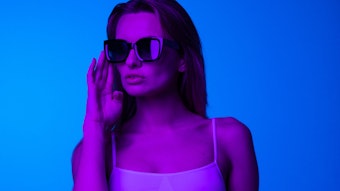
When someone talks about blue light, an image of a twinkling blue light might come to mind. However, in the skin care and personal care world, blue light is anything but sparkly-looking magic. Blue light or high energy visible light (HEVL) falls in the 400-500 nm range, which causes skin damage including pigmentation, inflammation, weakening of the epidermal barrier and aging effects among other problems.
“Long-term exposure to blue light, causes cells to produces reactive oxygen species—free radicals—which are responsible for premature skin aging and skin photo-aging,” explained Tatiana Giacinti senior marketing communications specialist at Kemin Industries, Inc. (“Kemin”) and Alberto Munoz senior business support specialist at Kemin.
“In the long run, this damage induces similar physiological responses in the skin to UV exposure; leading to cytotoxicity in human cells, which translate to the typical signs of premature skin aging such as loss of elasticity, dryness and fine lines,” they added.
What’s the Damage?
Whether from sunlight or from artificial blue light off of electronic devices, blue light is all around us all the time. According to Mintel, U.S. millennials check their phones 157 times a day in comparison to adults who only check their phones 30 times a day. This exposes users to blue HEVL that affects sleep and reduces skin's antioxidant levels.
According to DSM, spending time in front of artificial blue light is increasing to the point where most countries are exposed for four hours per day on average.
A few of the company’s team members: Aline Hueber, head of Global Marketing Vitamins, Mathias Gempeler, Ph.D., head of Global Marketing Skin Care and Jochen Klock, Ph.D., head of Global Marketing Sun Care at DSM discussed the sources of blue light and how it damages skin.
“While UV damage from the sun is well documented, until now less attention has been paid to the fact that blue light comes ‘right after’ UVA light in terms of wavelength and energy and may also evoke adverse effects,” explained the team. “Recent studies show that blue light penetrated deep into the skin and therefore has the ability to damage all skin layers.”
Damage Prevention
Jessen Curpen, biophysics manager and head of Clinical Study Design at CIDP explained that blue light damage can be avoided by preventing the damage from reaching and penetrating the skin surface.
“Some laboratories have developed specific filters to block blue light and these filters can be easily incorporated in ‘conventional’ sunscreen,” he added. “Thus, the use of sunscreen with specific blue light filters seems to be the best protection against blue light damage.”
Mintel recommends for brands to develop on-the-go products to revive skin and stop the effects of blue HEVL in addition to pushing for a protective claim package to include radiation from sun and pollution.
DSM has its own ideas in mind to protect the skin both outdoors and indoors:
- Block the blue light on the skin’s surface
- Counteract oxidative stress
- Stimulate skin’s own defense with highly innovative actives
The company also has the formulation, Total Protection into the Blue, to protect against blue light damage inside and outside.
“Based on a scientific justification of that newly identified trend DSM has the right portfolio in place to develop a strong claim substantiation based on cutting edge technologies: UV filter(s) that also have the ability to block blue light, selective vitamins counteract oxidative stress and a new microalga (Scenedesmus rubescence) derived bioactive that stimulates skin´s own defense,” the team added.
Meanwhile, the team from Kemin presented cosmetic ingredient FloraGLO Lutein Topical, which is based from lutein, a carotenoid part of the xanthophyll family with the ability to absorb blue light.
“We believe daily protection against blue light is a great way to proactively fend off against its negative impact on the skin,” the Kemin team explained. “By utilizing/introducing products into your daily personal care regimen that include ingredients that shield the skin from this wavelength, you may be able to minimize the signs of blue light damage and help prevent them.”
The Blue Light Trend
While the personal care industry is slowly beginning to pick up on the topic of blue light damage, this issue has actually always been present from sunlight.
According to DSM, “Only about a decade ago, the first smartphones have been introduced—and the future of the world lays in digitalization. Therefore, we clearly expect a constant increase of the artificial blue light damage, however, the detailed impact needs to be further scientifically investigated.










